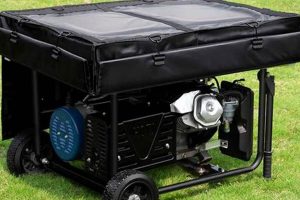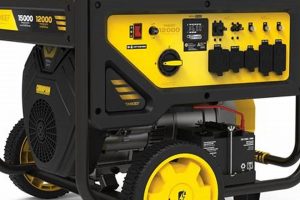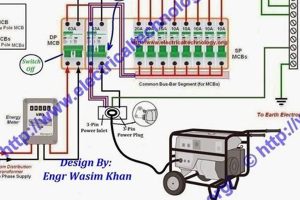A generator capable of producing 220 volts of electricity offers a portable power solution for various applications. This type of power source typically utilizes an internal combustion engine to drive an alternator, converting mechanical energy into electrical energy. Examples include powering tools on construction sites, providing backup electricity during outages, and facilitating outdoor events where grid power is unavailable. They come in varying sizes and power outputs, suitable for powering anything from small appliances to larger equipment.
Access to reliable electricity is crucial in modern life. Portable units capable of delivering this specific voltage play a vital role in ensuring continuity of operations in diverse settings. Historically, reliance on stationary generators or complete lack of power in remote locations limited productivity and convenience. The advent of such mobile power sources revolutionized industries and enabled activities previously impossible without a fixed power grid connection. This advancement significantly enhanced productivity, safety, and recreational opportunities.
This article delves further into key aspects of these power sources, covering topics such as selecting the appropriate size, proper operation and maintenance, safety considerations, and the latest advancements in portable generator technology.
Tips for Operating a 220-Volt Portable Generator Safely and Efficiently
Proper operation and maintenance are crucial for maximizing the lifespan and ensuring the safe usage of a generator capable of producing 220 volts. The following tips offer guidance for optimal performance and safety.
Tip 1: Calculate Power Requirements: Before selecting a unit, accurately calculate the total wattage required to power the intended devices. This prevents overloading and ensures sufficient power supply.
Tip 2: Proper Grounding: Ensure the generator is properly grounded to prevent electrical shocks and protect connected equipment. Consult the owner’s manual for specific grounding instructions.
Tip 3: Adequate Ventilation: Operate the generator in a well-ventilated area to prevent the buildup of carbon monoxide, a colorless, odorless, and potentially lethal gas.
Tip 4: Regular Maintenance: Adhere to the manufacturer’s recommended maintenance schedule, including oil changes, air filter cleaning, and spark plug replacement, to ensure optimal performance and longevity.
Tip 5: Fuel Safety: Allow the generator to cool completely before refueling to prevent fires. Store fuel in approved containers away from the generator.
Tip 6: Dry Operation: Never operate the generator in wet conditions without proper protection. Ensure the unit is placed on a dry, stable surface.
Tip 7: Connection Procedures: Utilize appropriate power cords and connectors designed for 220-volt applications. Avoid overloading individual outlets.
Tip 8: Professional Inspection: Periodically, have a qualified technician inspect the generator for any potential issues and ensure it operates safely and efficiently.
By following these guidelines, users can ensure safe and efficient operation, prolong the generator’s lifespan, and prevent potential hazards.
Understanding these key operational aspects paves the way for a more in-depth exploration of specific generator models and their respective functionalities in the sections that follow.
1. Power Output
Power output represents a critical specification for 220-volt portable generators, directly influencing their capacity to operate electrical devices. A clear understanding of power output is essential for selecting a generator that meets specific power demands. This section explores key facets of power output as it relates to these generators.
- Rated Power vs. Starting Power
Rated power (running watts) indicates the continuous power supply the generator can deliver, while starting power (surge watts) refers to the higher power output available for a short duration to start motor-driven appliances. A refrigerator, for instance, might require a higher starting wattage than its running wattage. Matching the generator’s starting and running wattage to the connected loads prevents overloading and ensures reliable operation.
- Wattage Requirements of Appliances
Different appliances have varying wattage requirements. Power tools, for example, typically demand higher wattage than electronics like laptops. Consulting appliance specifications and calculating the cumulative wattage is essential for selecting a generator with sufficient power output.
- Overload Protection
Generators often incorporate overload protection mechanisms, such as circuit breakers, to prevent damage from excessive power demands. Understanding the generator’s overload protection features and operating within its power output limits is crucial for safe and reliable operation.
- Efficiency and Fuel Consumption
Power output influences fuel consumption. Operating a generator at a lower output than its maximum capacity can improve fuel efficiency. Matching the generator’s power output to the load requirements optimizes fuel consumption and reduces operating costs.
Careful consideration of these power output facets allows for informed decisions regarding generator selection and usage. Selecting a generator with adequate power output for the intended application ensures efficient and reliable operation of connected devices while preventing potential damage from overloading.
2. Portability
Portability represents a defining characteristic of 220-volt portable generators, directly influencing their usability and suitability for various applications. This attribute encompasses factors such as weight, size, and maneuverability, enabling convenient transport and deployment in diverse locations. The interplay between portability and functionality significantly impacts user experience and practical application. Construction sites, for instance, often require mobile power solutions for tools and equipment in locations lacking fixed power sources. Similarly, emergency response teams utilize portable generators to restore critical services during power outages, highlighting the practical significance of portability in time-sensitive situations.
Further enhancing portability, features like built-in wheels, handles, and compact designs facilitate easy movement and storage. The trade-off between power output and portability necessitates careful consideration. Larger generators typically offer higher power output but compromise on portability, while smaller, more portable units may have limited power capacity. Outdoor enthusiasts, for example, might prioritize lightweight and compact generators for camping trips, accepting lower power output for essential appliances. Conversely, industrial applications might necessitate higher power output, potentially sacrificing some degree of portability. The selection process involves a nuanced understanding of the specific power requirements and portability needs.
In conclusion, portability significantly enhances the versatility and practicality of 220-volt portable generators. Careful consideration of size, weight, and maneuverability factors allows users to select the optimal balance between power output and portability based on their specific needs and intended applications. This understanding empowers informed decision-making and maximizes the utility of these portable power solutions across diverse scenarios, from construction sites and emergency response to recreational activities and remote locations.
3. Fuel Source
Fuel source constitutes a critical factor influencing the operation and selection of a 220-volt portable generator. The type of fuel directly impacts the generator’s runtime, maintenance requirements, environmental impact, and operational costs. Understanding the nuances of various fuel sources is essential for informed decision-making and optimal generator utilization.
- Gasoline
Gasoline offers widespread availability and facilitates quick starting. However, gasoline has a limited shelf life and requires periodic replenishment. Generators utilizing gasoline as fuel source are commonly employed in construction, emergency backup power, and recreational activities.
- Propane
Propane provides a cleaner-burning alternative to gasoline, resulting in reduced emissions and extended engine life. Propane’s longer shelf life makes it suitable for long-term storage and emergency preparedness. Propane-powered generators are often preferred for camping, RVing, and residential backup power.
- Diesel
Diesel offers higher fuel efficiency and longer runtimes compared to gasoline. Diesel generators are well-suited for demanding applications requiring continuous power supply, such as industrial operations and large-scale events. However, diesel engines typically require more substantial maintenance.
- Dual Fuel/Tri-Fuel
Dual fuel or tri-fuel generators offer operational flexibility by utilizing multiple fuel sources, typically a combination of gasoline, propane, and natural gas. This adaptability allows users to switch between fuels based on availability and cost-effectiveness. These generators are advantageous in areas with fluctuating fuel prices or limited access to specific fuel types.
The choice of fuel source directly impacts the practicality and cost-effectiveness of operating a 220-volt portable generator. Careful consideration of factors such as fuel availability, runtime requirements, environmental impact, and maintenance needs enables informed selection and optimal utilization across diverse applications. The selection of a specific fuel type will depend on the intended use case, operational environment, and budgetary constraints.
4. Safety Features
Safe operation of a 220-volt portable generator is paramount. These power sources present potential hazards if not handled correctly. Integrating comprehensive safety features mitigates risks and ensures user protection. Understanding these features and their functionality is crucial for responsible generator operation.
- Overload Protection
Overload protection mechanisms, such as circuit breakers, prevent damage to the generator and connected appliances by interrupting the circuit in case of excessive current draw. This safeguards against overheating and potential fires. For instance, attempting to power a high-wattage appliance beyond the generator’s capacity triggers the circuit breaker, preventing damage.
- Low-Oil Shutdown
Low-oil shutdown automatically stops the engine if the oil level drops below a critical threshold. This prevents engine damage due to insufficient lubrication, extending the generator’s lifespan. This feature is crucial for maintaining engine integrity during prolonged operation.
- Ground Fault Circuit Interrupter (GFCI)
GFCI protection detects imbalances in electrical current flow, indicating a potential shock hazard. GFCI outlets quickly interrupt the circuit, minimizing the risk of electrocution, particularly in damp environments. This feature is vital for outdoor use where exposure to moisture increases electrical risks.
- Carbon Monoxide (CO) Sensors/Shutdown
Generators produce carbon monoxide, a colorless, odorless, and potentially lethal gas. CO sensors detect elevated CO levels and trigger an automatic shutdown, protecting users from CO poisoning. This feature is crucial for safe indoor or enclosed-area operation, ensuring adequate ventilation is maintained.
These safety features work in concert to minimize risks associated with operating a 220-volt portable generator. Proper understanding and utilization of these features contribute significantly to safe and responsible power generation. Regular inspection and maintenance of these safety mechanisms further ensure their effectiveness in preventing accidents and protecting users.
5. Maintenance
Maintenance is essential for the longevity and reliable operation of a 220-volt portable generator. Neglecting routine maintenance can lead to decreased performance, increased fuel consumption, and potential system failures. Regular upkeep ensures consistent power delivery and extends the generator’s operational lifespan. A well-maintained generator provides dependable power during outages or in off-grid locations, while a poorly maintained unit can fail when needed most, resulting in costly repairs or replacements. For example, neglecting oil changes can lead to engine seizure, a costly repair that could have been avoided with routine maintenance.
Several key maintenance tasks contribute to optimal generator performance. Regular oil changes, as specified in the owner’s manual, ensure proper engine lubrication. Air filter cleaning or replacement prevents dust and debris from restricting airflow, optimizing combustion efficiency. Spark plug replacement, at recommended intervals, ensures reliable ignition. Fuel system maintenance, including cleaning the fuel tank and carburetor, prevents fuel contamination and ensures consistent fuel delivery. These procedures, while seemingly simple, significantly impact the generator’s long-term reliability and performance. For instance, a clogged air filter reduces engine efficiency, leading to increased fuel consumption and potential overheating. Conversely, a clean air filter allows for optimal airflow, promoting efficient combustion and maximizing power output.
In summary, a proactive maintenance schedule is crucial for maximizing the lifespan and reliability of a 220-volt portable generator. Regular upkeep, including oil changes, air filter cleaning, spark plug replacement, and fuel system maintenance, prevents costly repairs, optimizes performance, and ensures dependable power delivery when needed. Understanding the direct correlation between maintenance and reliable operation empowers users to protect their investment and maximize the generator’s utility throughout its operational life. Failure to adhere to a regular maintenance schedule can not only compromise the generator’s functionality but also create safety hazards.
Frequently Asked Questions
This section addresses common inquiries regarding 220-volt portable generators, providing concise and informative responses to facilitate informed decision-making and safe operation.
Question 1: How is the required generator size determined?
Generator sizing depends on the total wattage of the intended devices. Calculating the sum of running watts and considering the highest starting wattage among appliances ensures adequate power supply. Consulting an electrician is recommended for complex setups.
Question 2: What safety precautions are essential during operation?
Operating a generator in a well-ventilated area is crucial to prevent carbon monoxide buildup. Proper grounding and dry operation prevent electrical hazards. Allowing the generator to cool before refueling mitigates fire risks.
Question 3: What type of maintenance is required?
Regular maintenance includes oil changes, air filter cleaning or replacement, and spark plug replacement according to manufacturer specifications. Fuel system maintenance and periodic inspections by qualified technicians are also recommended.
Question 4: What are the different fuel options available?
Common fuel sources include gasoline, propane, and diesel. Dual-fuel or tri-fuel options offer flexibility. Fuel choice depends on factors such as availability, cost, and environmental considerations.
Question 5: What are the key considerations for portability?
Portability factors include weight, size, and integrated features like wheels and handles. Balancing portability with required power output is crucial depending on the intended application.
Question 6: How does a 220-volt generator differ from a 110-volt generator?
A 220-volt generator delivers higher voltage, suitable for powering larger appliances and equipment typically used in industrial settings or for specific power needs. 110-volt generators are commonly used for household appliances and electronics.
Understanding these key aspects of 220-volt portable generators contributes to safe and effective operation. Consulting manufacturer guidelines and seeking professional advice when needed further enhances safety and performance.
The subsequent section offers a concluding perspective on the utility and selection process for these essential power sources.
Conclusion
This exploration of 220-volt portable generators has provided a comprehensive overview of their functionality, benefits, and safe operation. Key aspects discussed include determining power requirements, understanding various fuel sources, prioritizing safety features, adhering to maintenance schedules, and recognizing the significance of portability. Careful consideration of these factors is essential for selecting the appropriate generator for specific needs, whether for industrial applications, emergency preparedness, or recreational activities.
Reliable access to power is crucial in modern society. Portable generators serve as vital resources, enabling productivity, safety, and convenience in diverse settings. Informed selection and responsible operation of these power sources ensure their efficacy and contribute to a more resilient and adaptable approach to power accessibility. Continued advancements in generator technology promise further enhancements in efficiency, portability, and sustainability, further solidifying their role in powering essential activities and supporting modern life.






